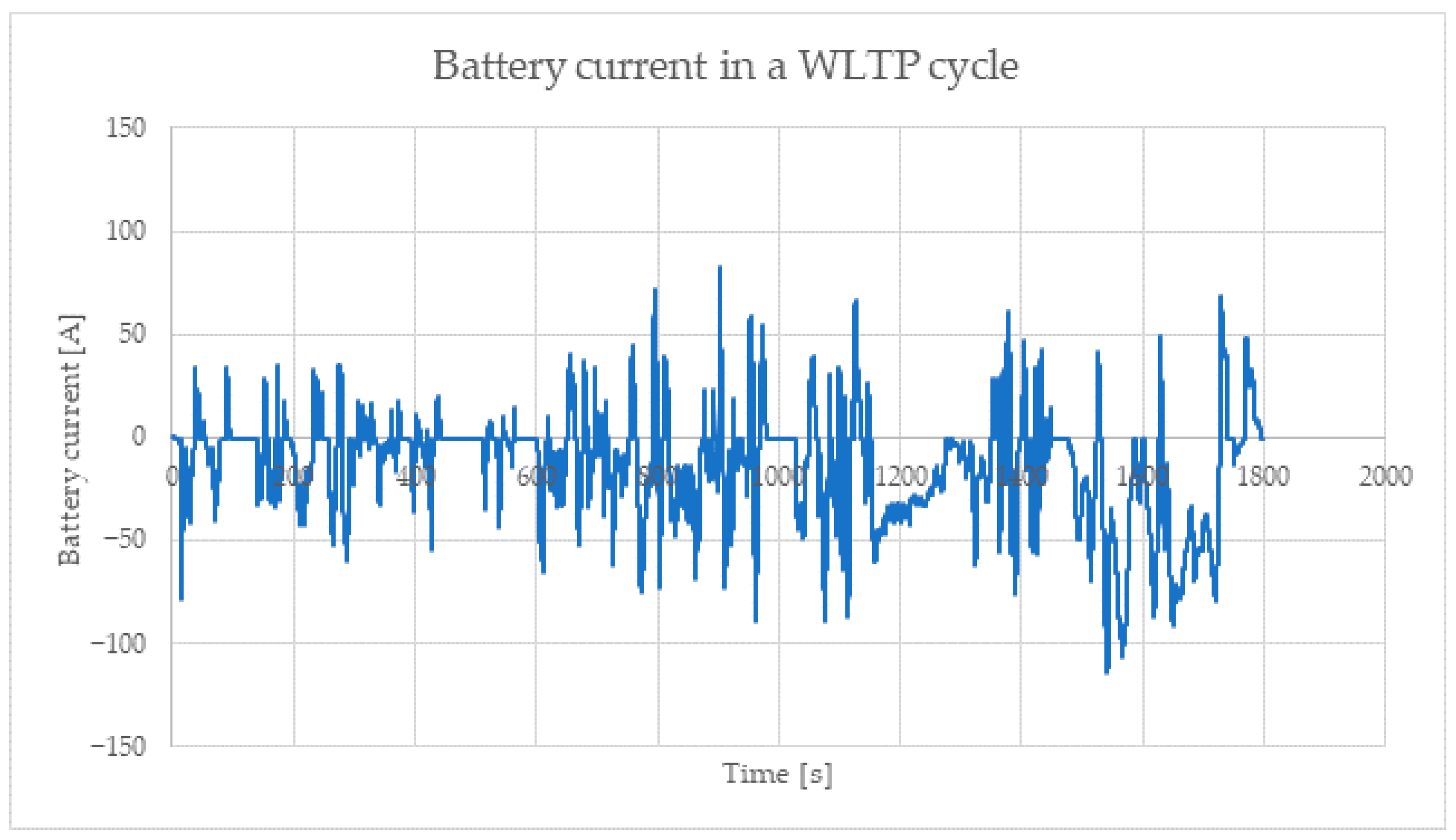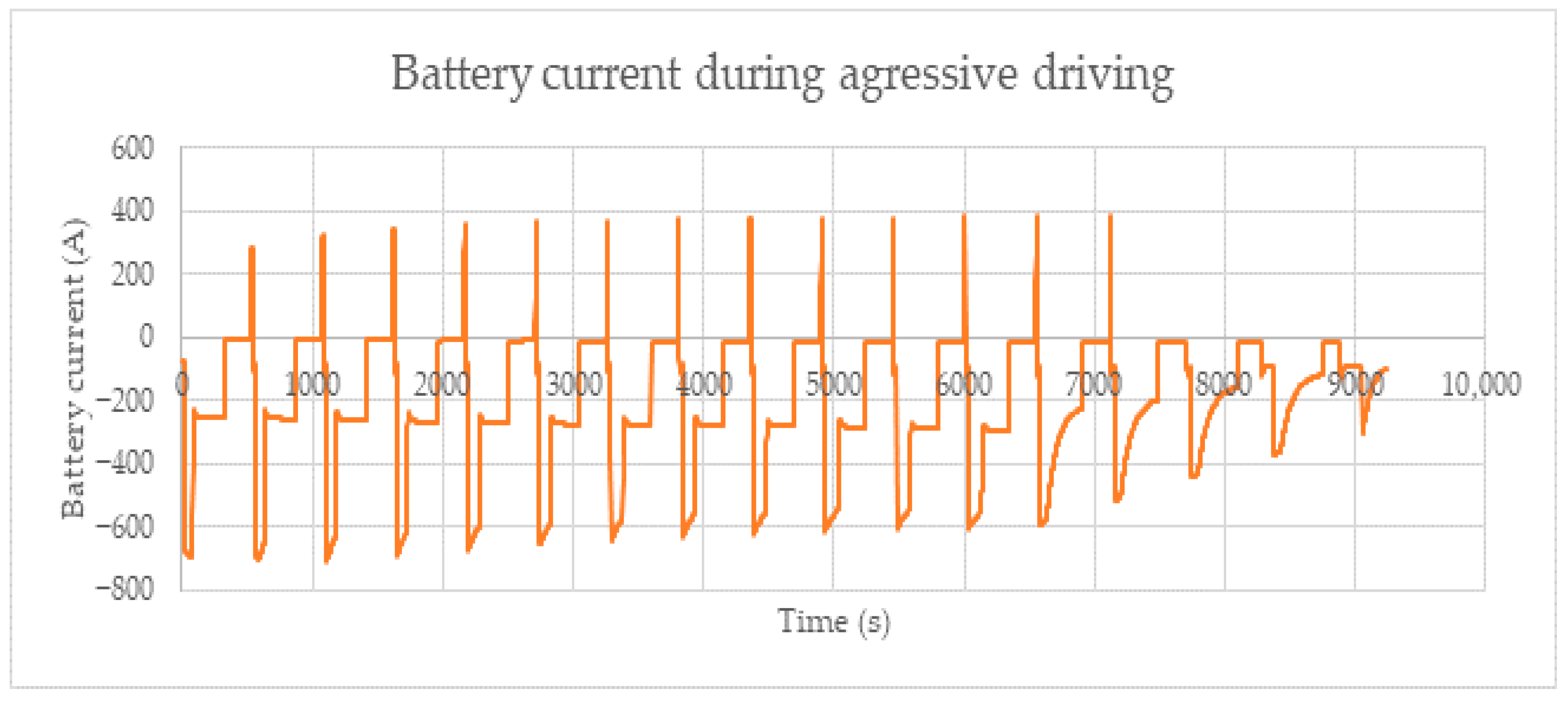User-Specific Load Profile Clustering for Automotive Battery Applications †
Abstract
1. Introduction
1.1. Vehicle Power System
1.1.1. Traction
1.1.2. Charging
1.1.3. Thermal Subsystem
1.1.4. Auxiliary Subsystem
1.2. Vehicle Lifecycle
1.2.1. Sleep State
1.2.2. Charging
1.2.3. Discharging (Driving)
2. Methods
2.1. Charging
2.1.1. Home Charging (3.5 and 11 kW)
2.1.2. Public Charging (22 kW AC)
2.1.3. Fast Charging (150 kW DC)
2.2. Discharging
2.2.1. Standard-Driven Load Profiles-WLTP
2.2.2. Real-Life Edge-Case-Driven Use Cases
2.2.3. Load Profile of the Thermal Subsystem
2.2.4. Sleep-State Load Profile
2.3. Comparison with Existing Load Modeling Approaches
3. Results and Discussion
4. Conclusions
Author Contributions
Funding
Institutional Review Board Statement
Informed Consent Statement
Data Availability Statement
Conflicts of Interest
References
- Rental Company Sixt Phases Out Tesla EVs From Fleet. Available online: https://insideevs.com/news/699689/tesla-sixt-ev-fleet/ (accessed on 15 July 2024).
- Pazmany, J.G.; Rechberger, K.; Baeker, B. Filter Design in the High Voltage System of Electric Vehicles with Respect to Ripple Limits. In Proceedings of the AmE 2020—Automotive Meets Electronics; 11th GMM-Symposium, Dortmund, Germany, 9–10 September 2020; VDE: Berlin, Germany, 2020. [Google Scholar]
- Liu, X.; Zhao, F.; Hao, H.; Chen, K.; Liu, Z.; Babiker, H.; Amer, A.A. From NEDC to WLTP: Effect on the Energy Consumption, NEV Credits, and Subsidies Policies of PHEV in the Chinese Market. Sustainability 2020, 12, 5747. [Google Scholar] [CrossRef]
- Sonderangebot mit Liefer-Engpass: Der VW e-Up im ADAC Test. Available online: https://www.adac.de/rund-ums-fahrzeug/autokatalog/marken-modelle/vw/vw-e-Up/ (accessed on 10 July 2024).
- Piepenbrink, H.; Flämig, H. Analysis of 160 Real-World BEV: Why the WLTP Undermines User Acceptance and How It Should Be Adjusted for Electric Vehicles. In Proceedings of the European Transport Conference (ETC 2023), Milan, Italy, 6–8 September 2023. [Google Scholar]
- Abdel-Monem, M.; Trad, K.; Omar, N.; Hegazy, O.; Van den Bossche, P.; Van Mierlo, J. Influence Analysis of Static and Dynamic Fast-Charging Current Profiles on Ageing Performance of Commercial Lithium-Ion Batteries. Energy 2017, 120, 179–191. [Google Scholar] [CrossRef]
- Singirikonda, S.; Yeddula Pedda, O. Investigation on Performance Evaluation of Electric Vehicle Batteries under Different Drive Cycles. J. Energy Storage 2023, 63, 106966. [Google Scholar] [CrossRef]
- Shelly, T.J.; Weibel, J.A.; Ziviani, D.; Groll, E.A. Comparative Analysis of Battery Electric Vehicle Thermal Management Systems under Long-Range Drive Cycles. Appl. Therm. Eng. 2021, 198, 117506. [Google Scholar] [CrossRef]
- Hu, L.; Dong, J.; Lin, Z. Modeling Charging Behavior of Battery Electric Vehicle Drivers: A Cumulative Prospect Theory Based Approach. Transp. Res. Part C Emerg. Technol. 2019, 102, 474–489. [Google Scholar] [CrossRef]
- Zhu, Q.; Huang, Y.; Lee, C.F.; Liu, P.; Zhang, J.; Wik, T. Predicting Electric Vehicle Energy Consumption from Field Data Using Machine Learning. IEEE Trans. Transp. Electr. 2025, 11, 2120–2132. [Google Scholar] [CrossRef]
- Ahmed, S.; Imtiaz, M.A.; Ahmad, B.; Ahmed, J.; Soomro, A.A.; Majeed, M.K.; Anjam, F.; Rafique, M. Next-Level System Design: Advanced and High-Performance System Architectures for the Future of Electric Vehicles. Spectrum Eng. Sci. 2025, 3, 262–282. [Google Scholar]
- Sitnik, L.J. A Method for Energy Consumption Assessment by Operation of BEVs in Different Road Conditions. J. KONES 2019, 26, 121–127. [Google Scholar] [CrossRef]
- Tewiele, S.; Driesch, P.; Weber, T.; Schramm, D. Clustering of Real BEV Driving Data with Subsequent Driving Cycle Construction Using Markov Chains. In Proceedings of the AmE 2018—Automotive Meets Electronics; 9th GMM-Symposium, Dortmund, Germany, 12–13 September 2018; VDE: Berlin, Germany, 2018. [Google Scholar]
- Schuster, S.F.; Brand, M.J.; Campestrini, C. Correlation Between Capacity and Impedance of Lithium-Ion Cells During Calendar and Cycle Life. J. Power Sources 2016, 305, 191–199. [Google Scholar] [CrossRef]
- Berzi, L.; Delogu, M.; Pierini, M. Development of Driving Cycles for Electric Vehicles in the Context of the City of Florence. Transp. Res. Part D Transp. Environ. 2016, 47, 299–322. [Google Scholar] [CrossRef]
- Das, D.; Ramesha, P.A.; Jana, M.; Basu, S. Generation of Drive Cycles for Electric Vehicles. In Proceedings of the 2021 IEEE Transportation Electrification Conference (ITEC-India), New Delhi, India, 16–18 December 2021; IEEE: Piscataway, NJ, USA, 2021. [Google Scholar]
- Martyushev, N.V.; Malozyomov, B.V.; Sorokova, S.N.; Efremenkov, E.A.; Qi, M. Mathematical Modeling the Performance of an Electric Vehicle Considering Various Driving Cycles. Mathematics 2023, 11, 2586. [Google Scholar] [CrossRef]
- Anseán, D.; González, M.; Viera, J.C.; García, V.M.; Blanco, C.; Valledor, M. Fast Charging Technique for High Power Lithium Iron Phosphate Batteries: A Cycle Life Analysis. J. Power Sources 2013, 239, 9–15. [Google Scholar] [CrossRef]




Disclaimer/Publisher’s Note: The statements, opinions and data contained in all publications are solely those of the individual author(s) and contributor(s) and not of MDPI and/or the editor(s). MDPI and/or the editor(s) disclaim responsibility for any injury to people or property resulting from any ideas, methods, instructions or products referred to in the content. |
© 2025 by the authors. Licensee MDPI, Basel, Switzerland. This article is an open access article distributed under the terms and conditions of the Creative Commons Attribution (CC BY) license (https://creativecommons.org/licenses/by/4.0/).
Share and Cite
Pazmany, J.G.; Szeli, Z.; Enisz, K. User-Specific Load Profile Clustering for Automotive Battery Applications. Eng. Proc. 2025, 113, 74. https://doi.org/10.3390/engproc2025113074
Pazmany JG, Szeli Z, Enisz K. User-Specific Load Profile Clustering for Automotive Battery Applications. Engineering Proceedings. 2025; 113(1):74. https://doi.org/10.3390/engproc2025113074
Chicago/Turabian StylePazmany, Jozsef Gabor, Zoltan Szeli, and Krisztian Enisz. 2025. "User-Specific Load Profile Clustering for Automotive Battery Applications" Engineering Proceedings 113, no. 1: 74. https://doi.org/10.3390/engproc2025113074
APA StylePazmany, J. G., Szeli, Z., & Enisz, K. (2025). User-Specific Load Profile Clustering for Automotive Battery Applications. Engineering Proceedings, 113(1), 74. https://doi.org/10.3390/engproc2025113074





